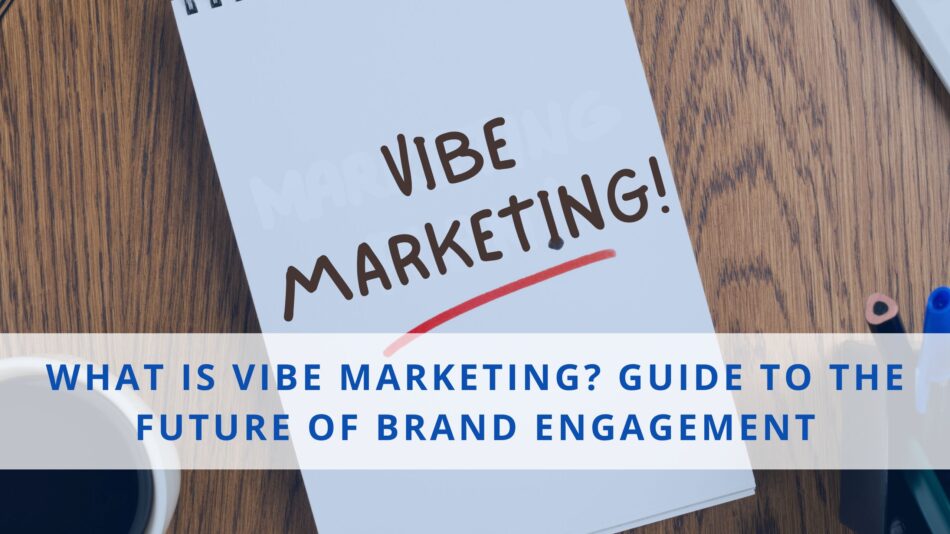In a world where consumers are bombarded with messages every day, traditional marketing methods are no longer enough to capture attention. Vibe Marketing is emerging as a transformative approach that focuses on creating emotional resonance, cultural relevance, and immersive experiences. Rather than simply promoting products or services, Vibe Marketing allows brands to connect with audiences on a personal and emotional level, creating long-lasting loyalty and engagement.
What Sets Vibe Marketing Apart
Unlike conventional marketing that emphasizes features, specifications, and price points, Vibe Marketing emphasizes the feel of a brand. It’s about creating a cohesive energy that reflects a brand’s identity and aligns with the audience’s emotions. This approach transforms brand interactions into meaningful experiences, fostering relationships that go beyond one-time transactions.
Modern consumers, particularly Gen Z and millennials, value authenticity and experiences over material possessions. Brands that can capture the right vibe—through storytelling, visual aesthetics, and cultural relevance—stand out and build lasting influence.
Core Elements of Vibe Marketing
A successful Vibe Marketing strategy revolves around three essential pillars: authenticity, emotion, and immersion.
- Authenticity: Brands must be transparent and consistent in their messaging. Authenticity helps build trust and credibility.
- Emotion: Connecting with the audience through feelings—joy, nostalgia, empowerment—strengthens loyalty and encourages advocacy.
- Immersion: Creating interactive and engaging experiences ensures that audiences are actively involved with the brand rather than passive observers.
By combining these pillars, brands can craft campaigns that resonate deeply and create meaningful connections with their audience.
How Vibe Marketing Changes the Brand-Audience Relationship
Traditional marketing often treats audiences as passive recipients of information. Vibe Marketing, however, positions them as active participants in a brand’s story. Through emotional storytelling, immersive experiences, and culturally relevant content, brands invite audiences to be part of their identity.
For example, a lifestyle brand might organize a virtual event or challenge where participants can share their personal stories, creating a sense of belonging. Every touchpoint, from social media to product packaging, reinforces the brand’s vibe, turning everyday interactions into emotionally charged experiences.
The Psychology Behind Vibe Marketing
Emotions play a pivotal role in decision-making. Research indicates that emotional engagement can drive brand loyalty and advocacy more effectively than rational messaging. Vibe Marketing capitalizes on this by building subconscious associations between the brand and positive feelings.
Humans naturally gravitate toward communities and experiences that feel authentic and relatable. Vibe Marketing leverages this behavior by creating shared experiences, both online and offline, where audiences feel included, valued, and emotionally connected to the brand.
Strategies for Implementing Vibe Marketing
To execute Vibe Marketing effectively, brands must integrate creativity, authenticity, and strategic planning. Key strategies include:
- Consistent Brand Aesthetic: Maintain a cohesive look and feel across all touchpoints, from social media visuals to website design.
- Influencer Partnerships: Collaborate with influencers who naturally reflect the brand’s energy to enhance credibility and reach.
- Interactive Experiences: Host live events, immersive campaigns, or digital challenges that encourage audience participation.
- Storytelling: Share authentic narratives that resonate with the audience’s values, aspirations, and emotions.
- Cultural Alignment: Tap into social trends, lifestyle movements, and cultural moments to remain relevant and relatable.
Consistency in these strategies ensures that every interaction reinforces the brand’s vibe and strengthens emotional engagement.
Role of Social Media in Vibe Marketing
Social media has become the primary channel for Vibe Marketing. Platforms such as TikTok, Instagram, and YouTube enable brands to share authentic content in real-time. User-generated content, behind-the-scenes glimpses, and short-form storytelling foster a sense of community and emotional attachment.
For example, TikTok campaigns that leverage humor, creativity, or relatability often achieve viral success because they feel genuine and human. Instagram Reels and Stories allow brands to deliver immersive, interactive content that keeps audiences engaged and emotionally connected.
Examples of Brands Excelling in Vibe Marketing
- Nike: Campaigns like “Just Do It” and “You Can’t Stop Us” create strong emotional narratives that resonate globally.
- Apple: Minimalist design, aspirational messaging, and innovative product launches consistently convey a lifestyle vibe.
- Starbucks: Seasonal campaigns, curated playlists, and community engagement craft a comforting and relatable vibe.
- Glossier: By focusing on user-generated content and authentic engagement, Glossier has created a loyal community that shares the brand’s lifestyle values.
These examples show that Vibe Marketing can transcend industries, offering powerful ways to enhance engagement and brand loyalty.
Measuring Vibe Marketing Success
Although Vibe Marketing emphasizes emotion, its effectiveness can be measured through:
- Engagement Metrics: Likes, shares, comments, and interactions reflect audience resonance.
- Brand Sentiment: Monitoring online conversations and feedback provides insights into emotional alignment.
- Community Growth: Tracking follower growth and active participation highlights audience engagement.
- Repeat Interactions: Frequent engagement in campaigns, events, or content sharing indicates strong emotional connection.
Combining these quantitative and qualitative metrics enables brands to refine their strategies and maintain a consistent, impactful vibe.
The Future of Vibe Marketing
As technology evolves, Vibe Marketing will increasingly integrate AI, AR, and personalization. This will allow brands to deliver individually tailored emotional experiences while maintaining authenticity. The next era of brand engagement will prioritize feelings, experiences, and cultural resonance, making Vibe Marketing a central pillar of marketing strategies for forward-thinking brands.
About Us:
At BusinessInfoPro, we empower entrepreneurs, small businesses, and professionals with cutting-edge insights, strategies, and tools to fuel growth. Driven by a passion for clarity and impact, our expert team curates’ actionable content in business development, marketing, operations, and emerging trends. We believe in making complex ideas simple, helping you turn challenges into opportunities. Whether you’re scaling, pivoting, or launching a new, Businessinfopro offers the guidance and resources to navigate today’s dynamic marketplace. Your success is our commitment, because when you thrive, we thrive together.







